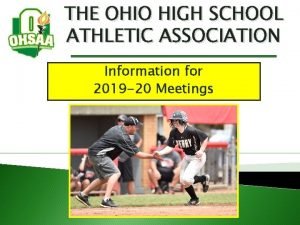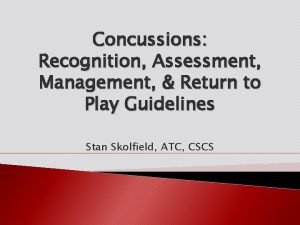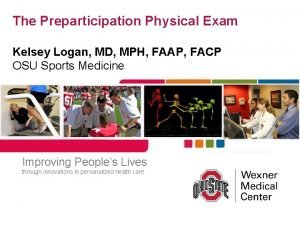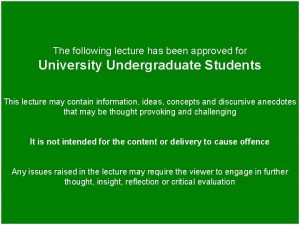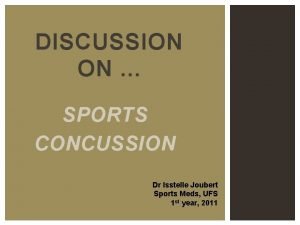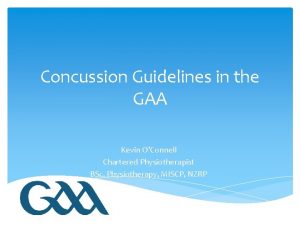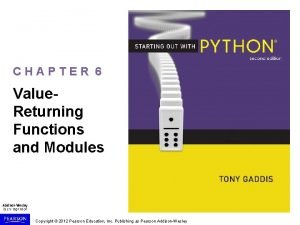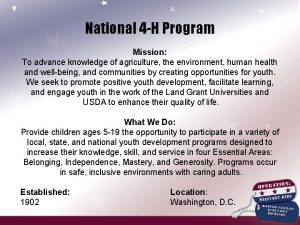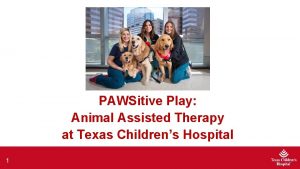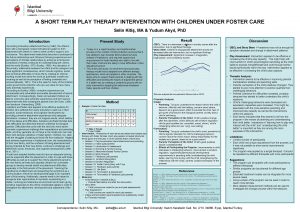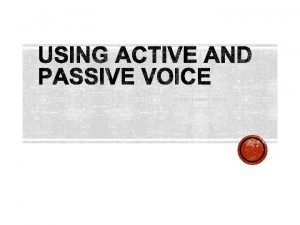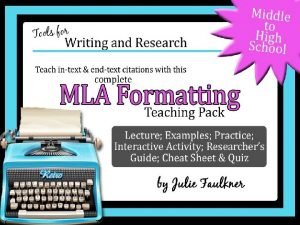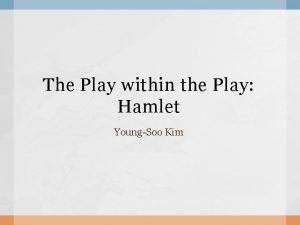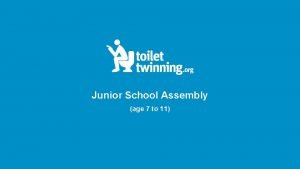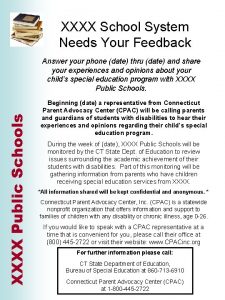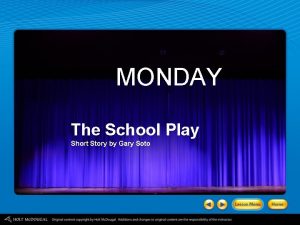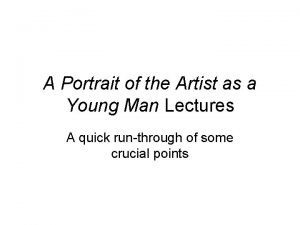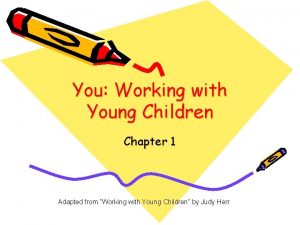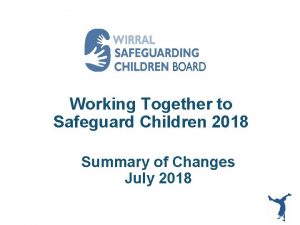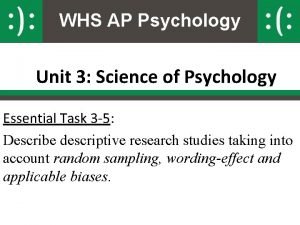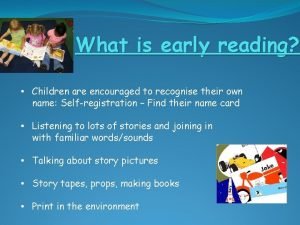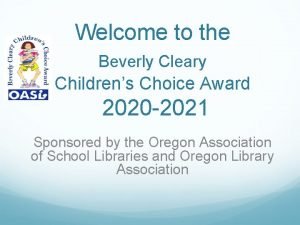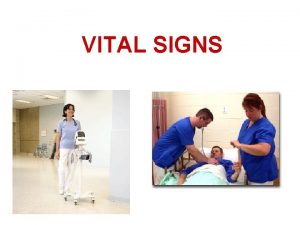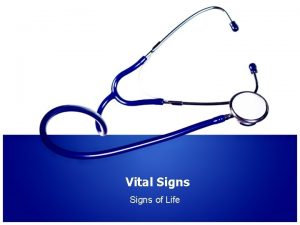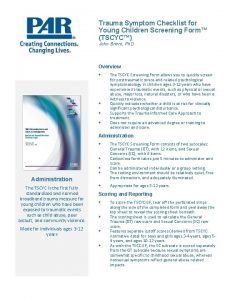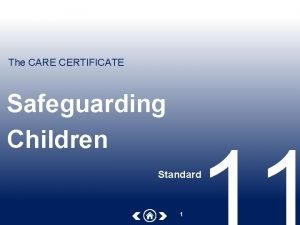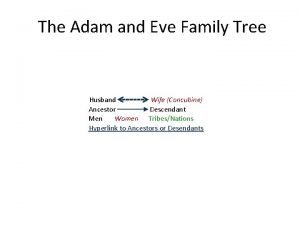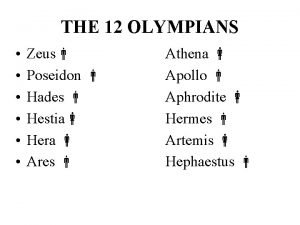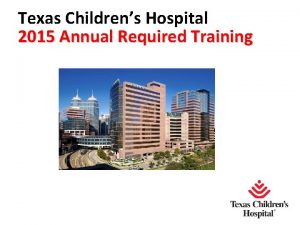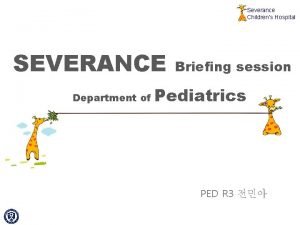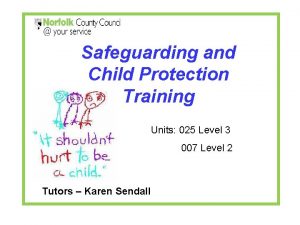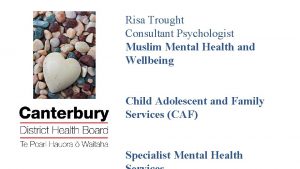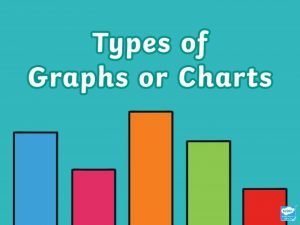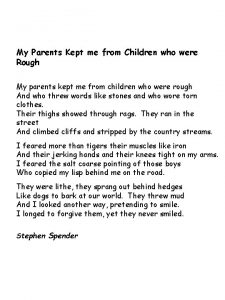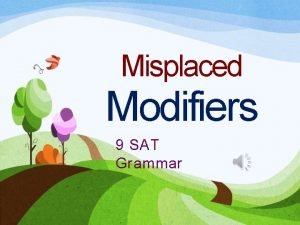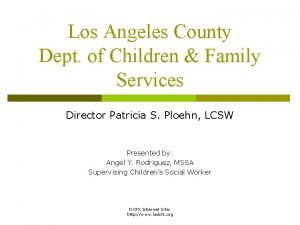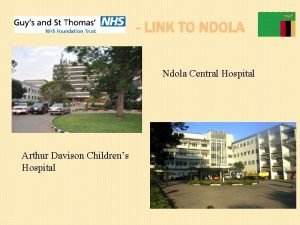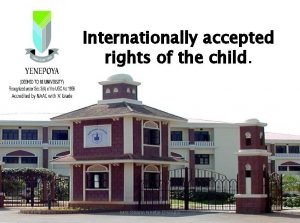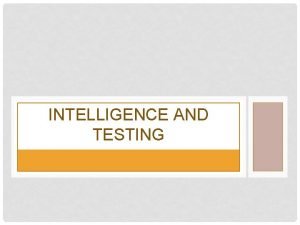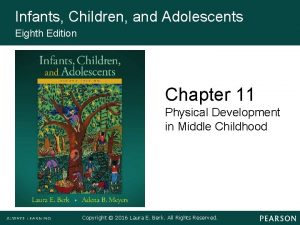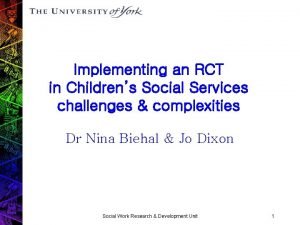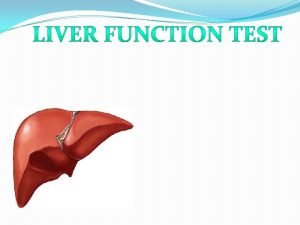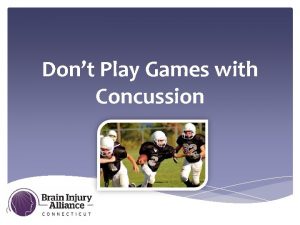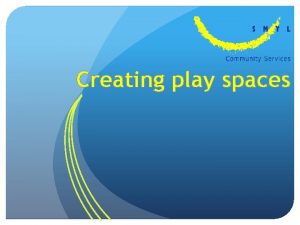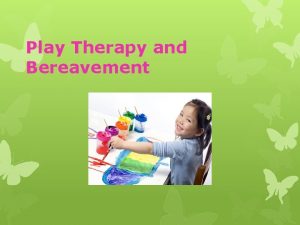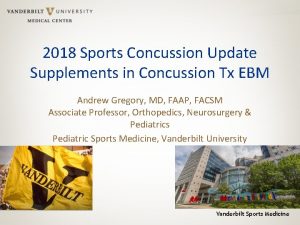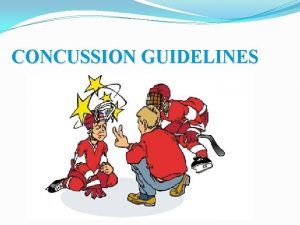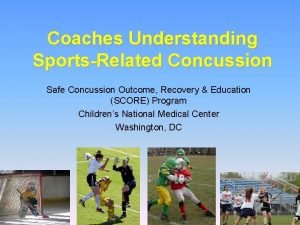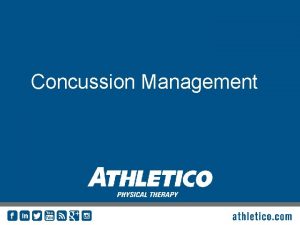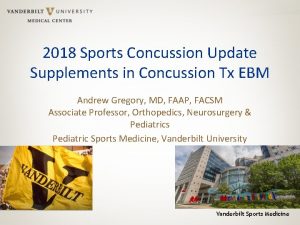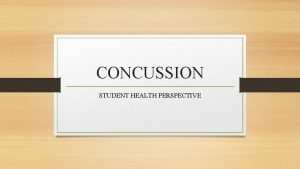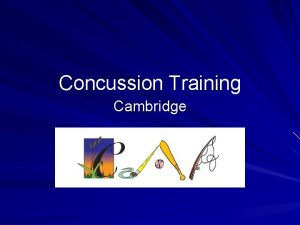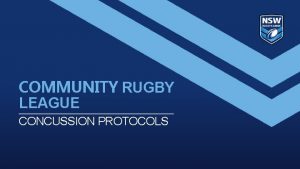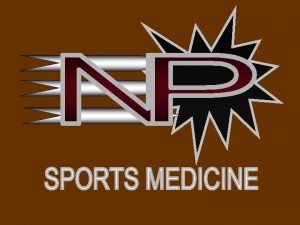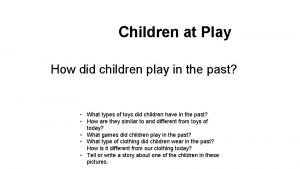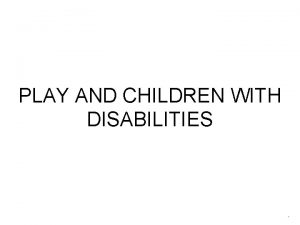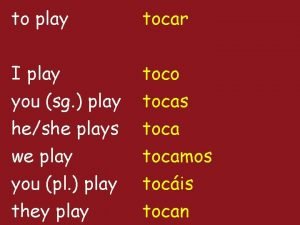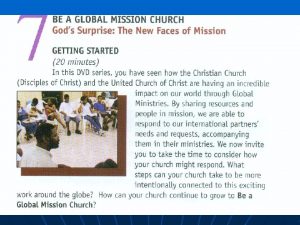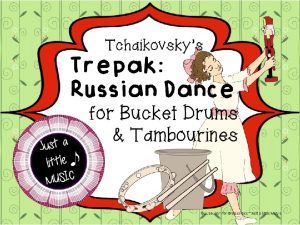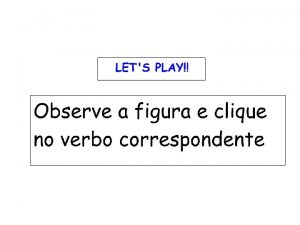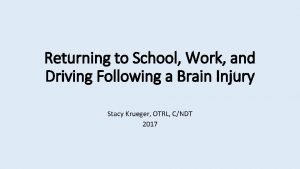Returning Children to Play School Following Concussion What









































































- Slides: 73

Returning Children to Play & School Following Concussion: What you need to Know Seattle Pacific University Educational Series February 3, 2015 Chris Ladish, Ph. D Pediatric Neuropsychology Mary Bridge Pediatric Psychology & Psychiatry Service 1220 Division Avenue Tacoma, WA 98403 (253) 403 -4437, #2 http: //www. multicare. org/marybridge/pediatricpsychology-psychiatry-3

Learning Objectives Discuss the physical, cognitive and emotional symptoms of concussion 2. Discuss the educational implications of concussion symptoms 3. Understand risk factors in prolonged concussion recovery 4. Assist in the development of appropriate physical, educational and cognitive recommendations in the return to learn and return to play decision-making process 1.

A Concussion IS a BRAIN INJURY

Terms To Avoid Ding Got his/her bell rung Saw Stars Just a Concussion

Basic facts 3. 9 million activity/sports related concussions per year (CDC) Ø Falls, accidents and assault Ø Media attention- professional sports, legislation Ø Ø Nearly all states now have legislation regarding sports concussions Ø Washington was the first state to have such a law ØNo athlete may return to sports if concussion suspected ØFurther evaluation by licensed professional

Zurich 2008 Consensus Definition of Concussion Complex pathophysiological process effecting the brain induced by traumatic biomechanical forces. May be caused by direct blow to head, face or neck, or elsewhere on body with “impulsive forces” transmitted to head. Typically involves rapid onset of short-lived impairment of neurological function that resolves spontaneously.

Zurich 2008 Consensus Definition of Concussion Clinical symptoms largely reflect functional disturbance rather than structural injury. Results in graded set of clinical symptoms that may or may not involve LOC. No abnormality evident on standard neuroimaging.

PECARN � CT scan rate 35. 3% � Traumatic Brain Injury 5. 2% � ci. TBI 0. 9% � Neurosurgical intervention 0. 1% 8

Zurich 2012 Updates Removal from field if concussion sustained SCAT 3 work group developed to improve SCAT 2 Validating SCAT for pediatric pts < 8 yo Evolving condition, reassessments needed “Bell ringers” = transient dysfunction of neurological function (mgmt ? ? ? ) Injury 2 days rest (> 10 days possibly harmful) graded exercise even if sxs persist

Core Areas Effected by Concussion Physical Cognitive Emotional Sleep

Physical Symptoms: headache nausea/vomiting imbalance (ataxia), motor problems excessive drowsiness, fatigue photosensitivity auditory sensitivity numbness, tingling blurry or double vision (diploplia)

Cognitive Symptoms: Less impact on crystallized skills Intelligence General language functioning Knowledge base (long term memory)

Cognitive Symptoms: Areas of Highest Risk Ø Ø Ø Ø Awareness/Orientation Attention Mental Flexibility Working Memory Executive Functioning Processing Speed Reaction Time

Cognitive Challenges can have Broad Effects Core deficits seen in concussion have functional effect on other skills Trends may be subtle but significant Day to day work, play, relationships and life impacted by key challenge areas.

Emotional Change in Concussion Disinhibition Emotional Lability Irritability/Reactivity Anxiety Depression Frustration Hopelessness Downplaying impact

Initial Symptom Presentation in Concussion (moments—days) Confusion, disorientation Retro/anterograde amnesia Headache Nausea, vomiting Motor weakness, incoordination Dizziness, imbalance Sensory sensitivity (light, sound) Fatigue, increased need for sleep

“Later” Symptom Presentation in Concussion (moments-weeks) Decreased processing speed Short-term memory impairment Difficulty retaining new information Irritability, depression, anxiety Fatigue, sleep disturbance “Foggy” feeling Frustration


TBI by Age High risk age groups: Children aged 0 to 4 years Adolescents 15 to 19 years

TBI by Gender TBI rates higher for females > males in similar sports › Girls 1. 7/10, 000 AE > Boys 1. 0/10, 000 Boys 0 to 4 years = highest rates of TBI-related ED visits, hospitalizations, and deaths

Leading Causes of TBI

Concussion in HS Sport: percent of overall concussions Football: 47. 1% Girls’ soccer: 8. 2% Boys’ wrestling: 5. 8% Girls’ basketball: 5. 5% Marar M, Mc. Il. Vain NM, Fields SK, Comstock RD. Epidemiology of Concussions Among United States High School Athletes in 20 Sports. American Journal of Sports Medicine; 2012, Jan 27 (Epub ahead of print).

Concussion in HS Sport: mechanism of concussion Player to player contact: 70. 3% of incidents Player to playing surface: 17. 2% Marar M, Mc. Il. Vain NM, Fields SK, Comstock RD. Epidemiology of Concussions Among United States High School Athletes in 20 Sports. American Journal of Sports Medicine; 2012, Jan 27 (Epub ahead of print).

Concussion in HS Sport: Hockey 22% of all hockey injuries are concussion Marar M, Mc. Il. Vain NM, Fields SK, Comstock RD. Epidemiology of Concussions Among United States High School Athletes in 20 Sports. American Journal of Sports Medicine; 2012, Jan 27 (Epub ahead of print).

Leading Causes of TBI Struck By/Against Events Includes colliding with a moving or stationary object, as in sports Cause of 25% of TBI’s in children 0 -14 years

Impact Science Broglio, Univ. of Michigan, 2010

how hard? study cohort linear acceleration Pellman Professional (2003) (75% injury risk) 98 g Guskiewicz Collegiate (2007) (mean of 13 concussions) Broglio High school (2010) (CART of 13 concussions) 102. 8 g 96. 1 g

Biomechanics of Concussion

Biomechanics of a Concussion Metabolic Cascade (hours to days) Developing brain (neuroplasticity vs. increased vulnerability) Overuse (implications to exertion) Neuroanatomical involvement

Considerations in the Developing Brain Neuroplasticity: younger brains are still developing and thus are more resilient to trauma due to brain’s ability to form alternate neural connections for function. Vulnerability: higher mortality rate seen with TBI in younger children likely due to higher rate of cerebral edema. Animal models support both factors.

Overuse and Implications to Exertion Unilateral cortical lesions. Recovery of function associated with increased dendritic growth within uninjured cortex dependent upon use of the intact forelimb. Restraint of uninjured forelimb with overuse of the injured limb results in failed dentritic enhancement, increased lesion size in injured cortex, and longer behavioral deficits. Some mitigation with delayed use: no lesion increase but functional recovery still delayed.

Considerations Regarding Resumption of ‘Activity’ (Silverberg, N. and Iverson, G. , 2012. Jnl Head Trauma Rehab Thomas, D. , Apps, J. , Hoffmann, R. , Mc. Crea, M. , Hammeke, T. 2015. Pediatrics) Complete rest beyond 3 days probably not helpful in most cases (not all) Gradual resumption of preinjury, non impact activities should begin as soon as tolerated Supervised exercise of benefit to patients with persistent symptoms both physically and emotionally Caution re early restrictions establishing a “mindset” for recovery expectations

Evolution of Symptoms and General Recovery Trends: Physical symptoms and altered mental status usually first noted Physical symptoms often improve before cognitive. Cognitive symptoms may worsen during first 48 -72 hours due to cellular and metabolic changes. Majority of pediatric cases with mild injury are back to baseline at ? ? ?

Management of Concussion

Core Areas Effected by Concussion Physical Cognitive Emotional Sleep

Symptom Management: A Phased Approach Acute Phase (Injury – 3 days) Post Acute (3 days-3 months) Prolonged (PPCS) (> 3 months)

Management Timeline for m. TBI Activity restriction determined by extent of current injury, history of previous injuries, functional presentation of patient Ongoing evaluation to inform treatment needs and monitor recovery trends

Acute Phase (0 -3 days): symptom management Rest Reduction of Stimulation Reduction of Exertion › Physical, emotional & cognitive Modified Expectations

Post-Acute Phase (3 days- 3 mos): symptom management › Assessment of rehab needs › Education re care provider roles › Brief directed cognitive assessment (EF, working memory, stim tolerance, endurance) › Set and monitor activity restrictions › Support adjustment to activity limitations › Facilitate return to activity (and stimulation) › Reintegration to school

Education: Preschool – School Age What is Head Injury Recovery Course and What to Expect Symptoms & Management Resources

Cognitive Symptom Management Cognitive Rest Limit stimulation Time off from school Reduction in work Educational Accommodations (504, IEP)


What to do if they are not getting better? Ø Ø Ø Don’t panic 10 -20% of pediatric concussions can take 3 weeks or more HS athletes take twice as long as college/professional athletes to recover (1014 days vs. 3 -7 days) Younger kids take longer They will get better, even if it takes a while

Why do some take longer to get better? Ø Psychosocial stress Ø Bright kids Ø Anxiety Ø Depression Ø Chronic medical illness Ø Difficulties at home Ø Learning disabilities Ø ADHD Ø Dyslexia Ø Previous history Ø Concussions Ø Headaches Ø Family hx of HA Ø Sleep problems

The Special Case of the “High Achiever” Prior high standard of academic performance “Overnight” changes to functioning More time needed for homework/studying Frustration with current deficits Increased cognitive exertion exacerbates symptoms Teachers/peers not aware b/c student at grade level Student feels unsupported/deficits minimized At risk for depression/anxiety/pessimism re: future

Managing symptoms Ø Headache- most common Ø Makes concentration difficult Ø Avoid triggers (e. g. lights, noises, subjects (math, high level science, foreign language) Ø Is this present at baseline Ø Limit NSAIDs Ø Focus on sleep Ø Riboflavin, magnesium, fish oil Ø Occasionally consider amitriptyline or neuro referral

Managing symptoms Ø Dizziness/lightheadedness Ø Vestibular system/sensory organization problem Ø Usually worsened by quick movements, video or hallways Ø Vestibular therapy Ø Lightheaded- sense that they may pass out with position change Ø More problematic because of limited cerebral perfusion Ø Light aerobic activity or exercise in lying position Ø Careful position changes Ø Nausea Ø Zofran

Managing symptoms Ø Neck strain- often present with head injury Ø Sometime can drive symptoms, even cause dizziness Ø Treat with heat, PT, massage, even muscle relaxers at times

Managing Symptoms Ø Sleep disturbance – makes most symptoms worse Ø Can’t fall asleep, wake up at night, excessive napping Ø Affects ability to attend and focus, new learning is difficult Ø If you don’t sleep you can’t do anything well, even without a head injury Ø Treat aggressively- sleep hygiene, melatonin, sometimes other meds

Managing symptoms Ø Mental health Ø Head injuries have a way of unmasking underlying problems Ø Depression, anxiety, conversion disorder Ø Concussed kids lose coping strategies (high performance in sports or school, exercise for stress relief, social interaction, video games) Ø Address and normalize what they are going through Ø Psychology referral when necessary

Managing symptoms Ø Difficulty with concentration and short term memory Ø Often most persistent symptoms Ø School accommodations Ø Patience (often take months, reassuring when there is a trend toward improvement) Ø Often pre-existing learning issues Ø Stimulants on occasion Ø Cognitive rehabilitation Ø Neuropsychology referral

Returning to Learning

Consideration of referral to NP should be made when the following are present: Need for education re management Presence of preinjury risk factors: learning, attention, psychosocial Cognitive challenges School issues Change in behavior, mood, personality Undue parental, coach pressure re RTP Need for cognitive clearance for RTP

Return to Learn considerations Collaborative effort between student, parents, educators, coaches, and health care professionals Careful plan to facilitate transition/reduce risk of failure Focus on individual student needs (current functional deficits, pre-existing risk factors, academic status) Set clear goals with student Close monitoring and feedback to student/parents Adjust plan with recovery

Return to Learn Modifying the school schedule (reduced endurance, fatigue, processing) › Reduced school day/late arrival › More frequent breaks in school day › Additional study period/study skills class › Drop classes with significant new learning: foreign language, higher-level math and science classes (e. g. , calculus, physics, chemistry)

Return to Learn Safety precautions (increased vulnerability, Increased distractibility) › No PE › No activities in gym or on playground › No woodshop, auto mechanics, any class with risk of injury › Early dismissal from class to avoid crowded hallways

Return to Learn Environmental accommodations (inattention, sensory sensitivity) › Preferential seating › Reduction of distractions › Testing in a quiet environment › Avoid noisy environments (e. g. , cafeteria, assemblies) › Rest periods in nurse’s office if headaches/fatigue

Return to Learn Adjusting requirements/grading (reduced cognitive resource, fatigue, slowed processing) › Forgive missed work › Grades based on completed/representative work › “Freeze” grades › Assign incompletes › Use pass/fail option

Return to Learn Modifying assignments (processing, attention, memory, learning) › Decrease work load (e. g. , length of spelling/ vocabulary word list, even or odd math problems) › Use aides: calculators, computers, “cheat sheets” › Assign peer note-taker

Return to Learn Modifying tests (processing speed, retrieval) › Untimed testing option › Open book, “cheat sheets, ” note cards › Recognition tests (multiple-choice, T/F) › Assistance with first few steps/problems

Return to Learn Support for new learning › Review of previously learned academics › New material/concepts presented in context of familiar or already-acquired knowledge › New material/concepts broken down into small chunks › Multimodal instruction › Repeated exposure to novel information › Frequent review of new material

Return to Learn: Organization Implement schedules, calendars, to do lists Maintain pictures/lists of assignments Break down large tasks Frequent reinforcement Provide concrete time limits and communicate them directly (verbal, written, timer, task-based) Frequent feedback, and redirection if needed

Graduated Return to Play › › › Approximately 24 hours (or longer) in between each step If symptoms, stop activity, rest until symptom-free 24 hours, return to previous step If symptoms increase, seek medical attention 1. Light General Conditioning Exercises (Goal: Increase HR) 2. Moderate General Conditioning and Sport Specific Skill Work Individually (Goal: Add Movement, individual skill work) 3. Heavy General conditioning, skill work individually and with teammate. NO CONTACT (Goal: Add Movement, teammate skill work) 4. Heavy General conditioning, skill work, and team drills. No live scrimmages. VERY LIGHT CONTACT. (Goal: Team skill work, light static contact) 5. Full Team Practice with Body Contact

Computerized Assessment: Pros Quick to administer Administration “standardized” Randomized forms Serial tracking of recovery with less chance for practice effect Available to non-NP providers and can be given in schools and office. Some higher measurement sensitivity.

Computerized Assessment: Cons What are we truly measuring? Does less data lead to less ability to generalize findings? Response type constrained by computer Requires careful oversight of administration. Athletes “dumbing down” baseline screens.

Outcomes of Concussion/TBI Increased risk for another TBI with more severe symptom presentation Cumulative effects of repeated injuries Potential catastrophic or fatal outcomes of repeated injuries within short time period

Specific Risks for Children vs. Adults following Concussion/TBI Increased risk of sustaining concussion Longer recovery period from concussion Rapid early recovery from moderate/severe TBI but…

Long-term Outcomes of TBI Increased risk for Alzheimer’s disease Parkinson’s disease Other brain disorders associated w/ aging

Moving Towards Prevention

Protection

Legislation http: //www. cdc. gov/concussion

Closing Thoughts: Concussion is a multifaceted and complex functional injury. Neurocognitive symptoms may be present which are not immediately evident during the first few days of evaluation. Recovery course from concussion is variable with outcomes determined by previous risk factors, injury severity, past concussions and management. Caution is warranted with all concussions and return to activity remains a medical decision which should be informed by ongoing attention to physical, cognitive, and emotional factors.

Questions?
 Ohsaa eligibility rules
Ohsaa eligibility rules Concussion grade 3
Concussion grade 3 Grade 2 concussion
Grade 2 concussion 2 minute orthopedic exam
2 minute orthopedic exam Nausea vomitting
Nausea vomitting Pwcs concussion training 2021
Pwcs concussion training 2021 Concussion betekenis
Concussion betekenis Concussion protocol gaa
Concussion protocol gaa Land of the morning child of the sun returning
Land of the morning child of the sun returning Ipo chart python
Ipo chart python Ut tyler letter of appreciation
Ut tyler letter of appreciation Returning back to god
Returning back to god Powerschool huntsville
Powerschool huntsville Leaving returning it
Leaving returning it I conclude then returning to being feared and loved
I conclude then returning to being feared and loved Returning warrior workshop
Returning warrior workshop Texas children's pawsitive play
Texas children's pawsitive play Short-term play therapy for children
Short-term play therapy for children Every afternoon as they were coming from school
Every afternoon as they were coming from school I've got a friend we like to play we play together
I've got a friend we like to play we play together Play random play basketball
Play random play basketball Typewriter types
Typewriter types Hamlet kim
Hamlet kim In a school assembly eight children
In a school assembly eight children School children xxxx
School children xxxx The school play gary soto
The school play gary soto Year 4 multiplication and division
Year 4 multiplication and division School play
School play Working with young children/answer key chapter 1
Working with young children/answer key chapter 1 Working together to safeguard children 2020
Working together to safeguard children 2020 The lost children of rockdale county
The lost children of rockdale county Kraigher kristofferson
Kraigher kristofferson Children are encouraged to read
Children are encouraged to read Beverly cleary children's choice award
Beverly cleary children's choice award Jerky breathing
Jerky breathing Vital signs defintion
Vital signs defintion Vital signs normal range pediatrics
Vital signs normal range pediatrics Pictures of garbage the gipsy magna
Pictures of garbage the gipsy magna Unit 18 assessing children's development support needs p1
Unit 18 assessing children's development support needs p1 Tscyc screening form
Tscyc screening form Muddy children puzzle
Muddy children puzzle Did catherine parr have children
Did catherine parr have children Safeguarding children care certificate
Safeguarding children care certificate Lineage of adam and eve
Lineage of adam and eve Zeus children
Zeus children Moli texas children's
Moli texas children's Sos school multan
Sos school multan Schizophrenia warning signs
Schizophrenia warning signs Esra erdoğan
Esra erdoğan Severance children's hospital
Severance children's hospital Section 47 children's act 1989
Section 47 children's act 1989 Children grief
Children grief R.j. reynolds family tree
R.j. reynolds family tree Uncountable nouns ending with s
Uncountable nouns ending with s Pictogram show
Pictogram show Phonemic awareness in young children
Phonemic awareness in young children Children's pain scale
Children's pain scale Nikola tesla djetinjstvo
Nikola tesla djetinjstvo Existanxe
Existanxe My parents kept me
My parents kept me Yadier molina wife
Yadier molina wife Married whith children
Married whith children Placement of modifiers
Placement of modifiers Children and family services los angeles
Children and family services los angeles Arthur davison children's hospital
Arthur davison children's hospital Zeus and kronos were greek actors
Zeus and kronos were greek actors Internationally accepted rights of children
Internationally accepted rights of children Lewis terman
Lewis terman Infants and children 8th edition
Infants and children 8th edition Discontinuity of development
Discontinuity of development Rct children's services
Rct children's services Baidir
Baidir Hampshire early years advisory team
Hampshire early years advisory team Alkaline phosphatase: normal range by age
Alkaline phosphatase: normal range by age
